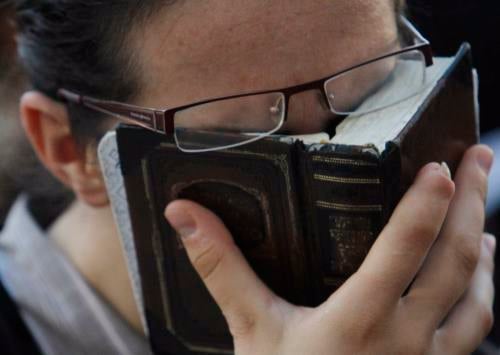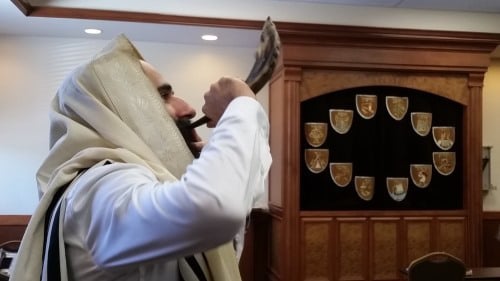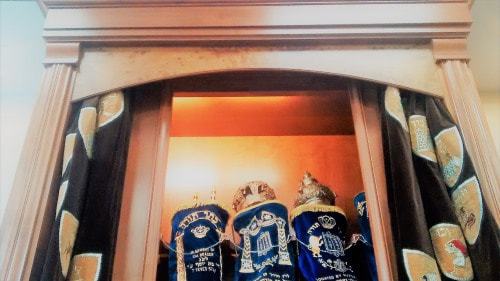
The Yom Kippur services begin with Kol Nidre, expressing our regret for any vows we may (inadvertently) make during the course of the year. There is a persistent (and romantic) myth that this formula was composed by the anusim, the Jews who were forced to convert to Catholicism in Spain during the Inquisition. Before convening for Yom Kippur services, they prayed that any lip service they paid to Christianity be seen as a sham and not a reflection of their true intent.
This is supposedly also the reason why Kol Nidre is prefaced with the statement: “. . . by the authority of the Heavenly Tribunal and by the authority of the earthly tribunal, we hereby grant permission to pray with the transgressors.”
Fact: Kol Nidre Predates the Spanish Inquisition By Hundreds of Years
While this is certainly an inspiring anecdote, and it is quite likely that anusim said this prayer with added fervor, they could not have invented it since Kol Nidre predates the Inquisition by at least 500 years. In fact, there is significant discussion in the Tosafot, composed in France and Germany several hundred years before the forced Spanish conversions, regarding the precise legal ramifications of this formula.
Indeed, many Sephardic Jews don’t even say Kol Nidre altogether, further discounting the notion that the text originated in Spain.
2. Myth: All Leather Is Forbidden on Yom Kippur

Some are under the mistaken belief that one may not wear a leather belt or garment on Yom Kippur.
Fact: Only Leather Shoes Are Out
The five “afflictions” of Yom Kippur include not wearing “sandals,” which tradition defines as leather footwear. Other leather garments, and all other footwear, are perfectly OK.
3. Myth: Unetaneh Tokef Was Composed by a Rabbi Who Asked to be Mutilated
9 Yom Kippur Myths and Misconceptions

The Yom Kippur services begin with Kol Nidre, expressing our regret for any vows we may (inadvertently) make during the course of the year. There is a persistent (and romantic) myth that this formula was composed by the anusim, the Jews who were forced to convert to Catholicism in Spain during the Inquisition. Before convening for Yom Kippur services, they prayed that any lip service they paid to Christianity be seen as a sham and not a reflection of their true intent.
This is supposedly also the reason why Kol Nidre is prefaced with the statement: “. . . by the authority of the Heavenly Tribunal and by the authority of the earthly tribunal, we hereby grant permission to pray with the transgressors.”
Fact: Kol Nidre Predates the Spanish Inquisition By Hundreds of Years
While this is certainly an inspiring anecdote, and it is quite likely that anusim said this prayer with added fervor, they could not have invented it since Kol Nidre predates the Inquisition by at least 500 years. In fact, there is significant discussion in the Tosafot, composed in France and Germany several hundred years before the forced Spanish conversions, regarding the precise legal ramifications of this formula.
Indeed, many Sephardic Jews don’t even say Kol Nidre altogether, further discounting the notion that the text originated in Spain.
2. Myth: All Leather Is Forbidden on Yom Kippur

Some are under the mistaken belief that one may not wear a leather belt or garment on Yom Kippur.
Fact: Only Leather Shoes Are Out
The five “afflictions” of Yom Kippur include not wearing “sandals,” which tradition defines as leather footwear. Other leather garments, and all other footwear, are perfectly OK.
3. Myth: Unetaneh Tokef Was Composed by a Rabbi Who Asked to be Mutilated

There is a haunting account attached to the cherished Yom Kippur prayer, Unetaneh Tokef, which contains the famous words, “… who by water, and who by fire; who by sword, and who by wild beast; who by earthquake, and who by pestilence … but repentance, prayer and charity avert the severity of the decree.”
The commonly told story, as it is indeed recorded in ancient texts, is that it was composed by Rabbi Amnon of Maintz, who told the Duke of Hessen to mutilate his body as punishment for him even considering converting to Christianity.
Fact: Rabbi Amnon Would Never Have Done Such a Thing
While this story is more than likely to contain truth, and Rabbi Amnon may very well have recited this prayer after being mortally mutilated by the duke, the commonly told version has some flaws: chiefly that Rabbi Amnon would never willingly ask for his limbs to be cut off, a violation of Torah’s regard for the human body and prohibition against mutilation. Another issue to contend with is that the prayer was said for hundreds of years before Rabbi Amnon lived, leaving us to conclude that Rabbi Amnon may very well have infused extra meaning into this chilling piece of liturgy, but he could not have been its originator.
4. Myth: Once You Broke the Fast, You Can Eat Freely

In English, eating after fasting is often referred to as “breaking a fast.” In addition to giving us the word “breakfast,” this has also led to an all-or-nothing attitude. “Once I’ve broken the fast by eating that cookie by mistake,” the rationale may go, “I may as well have a cup of coffee and that cinnamon bun I’ve been saving for tonight.”
Fact: Every Moment You Fast Is Valuable
Even if you made a mistake, your Yom Kippur is in no way invalidated. Life is a ladder, and what matters most is the direction in which you are climbing. If you’ve made a mistake, own up to yourself and to G‑d, express your regret, and resolve to improve. This process, called teshuvah (“repentance” or “return”), is actually central to your Yom Kippur experience.
Read: What Is Teshuvah?
5. Myth: Kids Fast Three Fasts Before Bar/Bat Mitzvah

There is a persistent myth that children must begin fasting the three fasts before their bar/bat mitzvah, no earlier and no later.
Thus, an 11-year-old girl whose birthday is 1 Nissan, for example, should fast on Yom Kippur, since it, 10 Tevet, and the Fast of Esther would be the final three fasts before she becomes an adult in the eyes of Jewish law.
Fact: This Has No Halachic Basis
Children are not obligated to perform mitzvahs before attaining bar or bat mitzvah. However, there are some who educate children to fast for a year (or several years) prior, depending greatly on the strength (and desire) of the child. While we do see a number of landmarks, ranging from age 9 to age 12, three fasts before adulthood is never given as a time to begin.
6. Myth: Yom Kippur Is a Sad Day

Perhaps because it shares some basic components with Tisha B’Av, our national day of mourning for the destruction of Jerusalem and the exile of our people, many view Yom Kippur as a sad day.
Fact: Yom Kippur Is a Joyous Day
The Talmud tells us that there were no days as joyous as 15 Av and Yom Kippur. That’s right; Yom Kippur is one of the two happiest days on the calendar! Why so happy? Well for one thing, it’s when G‑d forgives us for our sins, a day when we are cleansed from the baggage we picked up during the course of the year. How liberating is that!
On a deeper level: This forgiveness is achieved because this day is when we rise above the mundane humdrum of our lives. Like angels, we connect to our inner souls, and by extension, we are one with G‑d himself. Now that’s worth celebrating!
Read: At-Onement
7. Myth: The Most Important Thing is to Be in Shul

For many, the most important element of Yom Kippur is attending services and hearing the chazan chant the ancient prayers, so much so that they may even ride in the car or otherwise transgress the day’s laws in order to be present.
Fact: The Yom Kippur Laws Are Non-Negotiable
Like Shabbat, on Yom Kippur we may not do any of the 39
 s://www.chabad.org/library/article_cdo/aid/102032/jewish/The-39-Melachot.htm"> melachot, including causing combustion. For this reason, riding a car is forbidden, and when faced with the choice of driving to synagogue or remaining home, one should choose to remain home rather than drive during this sacred day.
s://www.chabad.org/library/article_cdo/aid/102032/jewish/The-39-Melachot.htm"> melachot, including causing combustion. For this reason, riding a car is forbidden, and when faced with the choice of driving to synagogue or remaining home, one should choose to remain home rather than drive during this sacred day.
8. Myth: The Shofar Ends the Fast

After we have fasted for 25 hours, one of the high points of the Neila (concluding) service is crying out the Shema in unison, followed by the sounding of the shofar. There is a common belief that the shofar blowing causes the fast to end, which has led some to mistakenly blow shofar and eat before night has fallen.
Fact: The Fast Ends When Stars Come Out
There are some who explain that we blow shofar to publicize that the evening following Yom Kippur is a holiday, and it is now time to feast and celebrate the closeness we’ve achieved and the forgiveness we’ve secured during this awesome day.
However, the shofar does not cause the fast to end any more than the dinging of your toaster makes your bread brown and crunchy. Rather, nightfall and Havdalah (see when that is in your area) are what permit a person to eat.
9. Myth: Yom Kippur Service Is a Typical Prayer Service
Many people attend synagogue only on Rosh Hashanah and Yom Kippur, and are dismayed to discover that the services are conducted in a language they don’t understand and seem to stretch on for h-o-u-r-s. It’s only natural for them not to want to come back. After all, why would they subject themselves to such an experience again and again?
Fact: That’s Like Coming to School Just for Exam Day
Imagine you decide to come to school only when absolutely necessary—the one day when you take an exam on all the material you’ve studied the entire year. Quite understandably, you’d consider school to be the most miserable, tortuous place, where you spend the entire day attempting to divine the answers to questions you don’t understand.
Obviously, if you’d come all year you’d know that school is an exciting place where you discover new information and enjoy the pleasure of learning. You’d also be well-positioned to answer the questions presented to you at the end-of-the-year exam.
So don’t be a stranger. Come to shul again and again, and you’ll discover the rhythm and reason behind the prayers. And even the extra-long High Holiday services won’t seem quite so long and bewildering!
There is a haunting account attached to the cherished Yom Kippur prayer, Unetaneh Tokef, which contains the famous words, “… who by water, and who by fire; who by sword, and who by wild beast; who by earthquake, and who by pestilence … but repentance, prayer and charity avert the severity of the decree.”
The commonly told story, as it is indeed recorded in ancient texts, is that it was composed by Rabbi Amnon of Maintz, who told the Duke of Hessen to mutilate his body as punishment for him even considering converting to Christianity.
Fact: Rabbi Amnon Would Never Have Done Such a Thing
While this story is more than likely to contain truth, and Rabbi Amnon may very well have recited this prayer after being mortally mutilated by the duke, the commonly told version has some flaws: chiefly that Rabbi Amnon would never willingly ask for his limbs to be cut off, a violation of Torah’s regard for the human body and prohibition against mutilation. Another issue to contend with is that the prayer was said for hundreds of years before Rabbi Amnon lived, leaving us to conclude that Rabbi Amnon may very well have infused extra meaning into this chilling piece of liturgy, but he could not have been its originator.
4. Myth: Once You Broke the Fast, You Can Eat Freely

In English, eating after fasting is often referred to as “breaking a fast.” In addition to giving us the word “breakfast,” this has also led to an all-or-nothing attitude. “Once I’ve broken the fast by eating that cookie by mistake,” the rationale may go, “I may as well have a cup of coffee and that cinnamon bun I’ve been saving for tonight.”
Fact: Every Moment You Fast Is Valuable
Even if you made a mistake, your Yom Kippur is in no way invalidated. Life is a ladder, and what matters most is the direction in which you are climbing. If you’ve made a mistake, own up to yourself and to G‑d, express your regret, and resolve to improve. This process, called teshuvah (“repentance” or “return”), is actually central to your Yom Kippur experience.
Read: What Is Teshuvah?
5. Myth: Kids Fast Three Fasts Before Bar/Bat Mitzvah

There is a persistent myth that children must begin fasting the three fasts before their bar/bat mitzvah, no earlier and no later.
Thus, an 11-year-old girl whose birthday is 1 Nissan, for example, should fast on Yom Kippur, since it, 10 Tevet, and the Fast of Esther would be the final three fasts before she becomes an adult in the eyes of Jewish law.
Fact: This Has No Halachic Basis
Children are not obligated to perform mitzvahs before attaining bar or bat mitzvah. However, there are some who educate children to fast for a year (or several years) prior, depending greatly on the strength (and desire) of the child. While we do see a number of landmarks, ranging from age 9 to age 12, three fasts before adulthood is never given as a time to begin.
6. Myth: Yom Kippur Is a Sad Day

Perhaps because it shares some basic components with Tisha B’Av, our national day of mourning for the destruction of Jerusalem and the exile of our people, many view Yom Kippur as a sad day.
Fact: Yom Kippur Is a Joyous Day
The Talmud tells us that there were no days as joyous as 15 Av and Yom Kippur. That’s right; Yom Kippur is one of the two happiest days on the calendar! Why so happy? Well for one thing, it’s when G‑d forgives us for our sins, a day when we are cleansed from the baggage we picked up during the course of the year. How liberating is that!
On a deeper level: This forgiveness is achieved because this day is when we rise above the mundane humdrum of our lives. Like angels, we connect to our inner souls, and by extension, we are one with G‑d himself. Now that’s worth celebrating!
Read: At-Onement
7. Myth: The Most Important Thing is to Be in Shul

For many, the most important element of Yom Kippur is attending services and hearing the chazan chant the ancient prayers, so much so that they may even ride in the car or otherwise transgress the day’s laws in order to be present.
Fact: The Yom Kippur Laws Are Non-Negotiable
Like Shabbat, on Yom Kippur we may not do any of the 39 melachot, including causing combustion. For this reason, riding a car is forbidden, and when faced with the choice of driving to synagogue or remaining home, one should choose to remain home rather than drive during this sacred day.
8. Myth: The Shofar Ends the Fast

After we have fasted for 25 hours, one of the high points of the Neila (concluding) service is crying out the Shema in unison, followed by the sounding of the shofar. There is a common belief that the shofar blowing causes the fast to end, which has led some to mistakenly blow shofar and eat before night has fallen.
Fact: The Fast Ends When Stars Come Out
There are some who explain that we blow shofar to publicize that the evening following Yom Kippur is a holiday, and it is now time to feast and celebrate the closeness we’ve achieved and the forgiveness we’ve secured during this awesome day.
However, the shofar does not cause the fast to end any more than the dinging of your toaster makes your bread brown and crunchy. Rather, nightfall and Havdalah (see when that is in your area) are what permit a person to eat.
9. Myth: Yom Kippur Service Is a Typical Prayer Service
Many people attend synagogue only on Rosh Hashanah and Yom Kippur, and are dismayed to discover that the services are conducted in a language they don’t understand and seem to stretch on for h-o-u-r-s. It’s only natural for them not to want to come back. After all, why would they subject themselves to such an experience again and again?
Fact: That’s Like Coming to School Just for Exam Day
Imagine you decide to come to school only when absolutely necessary—the one day when you take an exam on all the material you’ve studied the entire year. Quite understandably, you’d consider school to be the most miserable, tortuous place, where you spend the entire day attempting to divine the answers to questions you don’t understand.
Obviously, if you’d come all year you’d know that school is an exciting place where you discover new information and enjoy the pleasure of learning. You’d also be well-positioned to answer the questions presented to you at the end-of-the-year exam.
So don’t be a stranger. Come to shul again and again, and you’ll discover the rhythm and reason behind the prayers. And even the extra-long High Holiday services won’t seem quite so long and bewildering!


